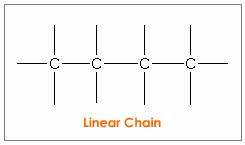The C-C and C-H bonds in organic compounds are very strong.These bonds generally do not break easily during the reactions.However;other atoms or groups such as Cl,OH,etc.,attached to the carbon atom may get replaced easily.For example,aqueous KOH reacts with haloalkanes to give the corresponding alcohol CH3-CH2-Cl +KOH(aq) = CH3-CH2-OH + KCl chloroethane ethanol
chemistry
Thursday, August 18, 2011
CATENATION
Carbon has a unique propery of liniking itself to other carbon atoms to give open chain or/and cyclic structures.This property of self-linking is termed catenation.Catenation is favoured by the atoms where atom to atom covalent bond is quite strong.In carbon,C-C bond enthlpy is very large(347.3kJ/mol).So,carbon shows catenation.
Carbon atom due to its tetravalency can be bonded to two,three or four carbon atom s by forming single and multiple bonds.Therefore,chains of carbon atoms may be linear,branched or cyclic.For example,
Catenation is responsible for the existence of such a large number of organic compounds.
Carbon atom due to its tetravalency can be bonded to two,three or four carbon atom s by forming single and multiple bonds.Therefore,chains of carbon atoms may be linear,branched or cyclic.For example,
Catenation is responsible for the existence of such a large number of organic compounds.
IONIGATION ENERGY AND ELECTRONEGATIVITY
The first ionisation energy(now ionisation enthalpy) of carbon atom is 1085kJ/mol.This value is very high .The electronegativity of carbon is 2.5,which is neither too low nor too high.Thus,carbon has no tendency to lose or gain electrons.As a result,it forms bonds only by mutual sharing of electrons and thus forms only covalent bonds.
Wednesday, August 17, 2011
CHARACTERISTICS OF CARBON ATOM
Carbon forms a very large number of compounds because of special characteristics of carbon atom such as:
ORGANIC CHEMISTRY
The number of organic compounds known today is about four million .Thousands of new ones are being synthesised and described daily.The ezistenc of such a large number of compounds of carbon is made possible by the unique bonding characteristics of the element.The three exceptional properties of carbon atom are:
1)Strong carbon-carbon bonds:Carbon is tetracovalent.It can link with other carbon atoms by strong carbon-carbon bonds.Thus carbon atoms can join together into stable chains and rings.
2)Covalent bonds with other elements:Carbon atoms linked as above can further be linked to atoms of other elements such as hydrogen ,oxygen,nitrogen and halogen.
3)Multiple bonds:Double and triple bonds between carbon atoms,and between carbon and other atoms are easily formed.
These multiple covalent bonds permit the formation of a still greater number of organic structures.
1)Strong carbon-carbon bonds:Carbon is tetracovalent.It can link with other carbon atoms by strong carbon-carbon bonds.Thus carbon atoms can join together into stable chains and rings.
2)Covalent bonds with other elements:Carbon atoms linked as above can further be linked to atoms of other elements such as hydrogen ,oxygen,nitrogen and halogen.
3)Multiple bonds:Double and triple bonds between carbon atoms,and between carbon and other atoms are easily formed.
These multiple covalent bonds permit the formation of a still greater number of organic structures.
Subscribe to:
Comments (Atom)












